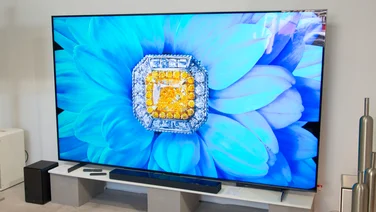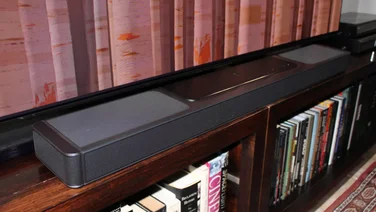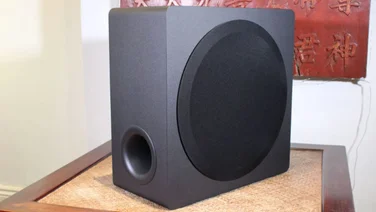To help us provide you with free impartial advice, we may earn a commission if you buy through links on our site. Learn more



The 65in Sony 65X9005a Ultra HD TV is colossal, even for a 65in TV, but that’s because Sony has added front-facing speaker drivers and separate tweeters to either side of the panel, which effectively takes up as much horizontal space as a 70in or larger TV would do. Sadly, there’s no way to remove the speakers should you want to use home cinema speakers and have a smaller TV.
They do at least sound superb; Sony’s magnetic fluid speaker drivers are able to pump out loud and clear audio that does justice to music, sports and TV shows.
Speakers aside, the TV itself is slim and stylish, with a minimal silver stand that gives the impression that the panel is floating above it. A single sheet of glass covers the entire front of the TV, so there are no breaks or joins when the screen is off, but it does highlight fingerprints so you’ll want to keep the 65X9005A out of reach of younger viewers.

Until Sony releases a firmware update to enable the X9’s HDMI 2.0 chip, the 65X9005A isn’t capable of playing Ultra HD footage at 50 or 60 frames per second, although all four HDMI inputs on the back of the set will happily play 24p or 30p video from a PC or compatible Ultra HD media streamer. In the meantime, the X9 also has component, composite and SCART video inputs for 1080p content, along with digital optical and analogue phono audio connection ports, an Ethernet port, a Common Interface slot and three USB ports, which can play just about any multimedia file from a flash drive or record live TV to an external hard disk.
You can also pair a smartphone or tablet to the TV for screen mirroring or content sharing via Wi-Fi Direct. You can easily pair devices using the NFC chip built into the X9’s front panel. Devices pair instantly when tapped against it. iOS users will need to pair their devices with the TV manually because no Apple product includes NFC. Connecting your mobile device is a great way of viewing your high-resolution photos that would be compressed when viewed on a Full HD TV.

If you run out of your own content you can start streaming on-demand video through Sony’s SEN Smart TV interface. It’s sensibly laid out with large icons and bold text, and there are more services here than on competing TVs with Netflix, LoveFilm, BBC iPlayer and Demand 5 being the highlights. Samsung still has the edge on Sony because it has a full selection of UK catch up TV, but Sony’s Music Unlimited and Video Unlimited services go a little way to make up for it with exclusive content you won’t get on any other service.
Of course, none of this on-demand content is being streamed in Ultra HD yet. To test the X9 properly we used Ultra HD open-source film Tears of Steel and some reference clips supplied by Sony. We found the level of detail to be simply breathtaking. You can clearly distinguish faces in a crowd of football fans, read the names on the back of players’ shirts and notice details in other scenes that would be impossible to spot in 1080p footage. The texture detail on clothing, brickwork and wood, facial features and incidental detail all look superb in Ultra HD.
The X-Reality Pro sharpens footage subtly and creates the impression of additional detail without introducing noise to the picture. The Sony 65X9005A produces the best looking Ultra HD images we’ve seen on a home TV so far.
Colour accuracy is also fantastic. Sony’s Triluminos technology helps create a more subtle blend of colours, which particularly enhanced the vibrant images seen in Sony’s Ultra HD wildlife footage.
Our only criticism was a slight tendency to show deep blacks as slightly off-grey; this is unnoticeable when watching anything but a very dark scene, but it’s unmistakeable once you’ve spotted it. Experimenting with the dynamic backlight couldn’t completely eradicate the issue, so if you want the absolute deepest blacks you’ll still need to look towards plasma technology (while it’s still around).
The 65X9005A also does a fantastic job of upscaling 1080p video to Ultra HD, mainly thanks to the Reality Creation setting. Reality Creation creates a greater sense of resolution by sharpening specific parts of a given image. It’s an effective method, which ensures you get a picture that’s just as good as a native 1080p TV.
Although standard definition pictures look fairly average, that in itself is an achievement considering the source material and the number of pixels the standard definition video is being stretched to fill. Sony’s various noise reduction and image creation techniques work together excellently to clean the picture as much as possible, although very low bit rate channels such as Dave and BBC News still look pretty ropey when you get close to the screen.

Unusually for a Sony TV this one uses passive 3D technology
Unusually for Sony, the X9 uses passive technology to produce 3D video rather than active shutter glasses. This makes a lot of sense. You lose half the vertical resolution with passive 3D, but on a 4K panel you still see Full HD picture. Essentially, you get the resolution of active 3D, but the benefits of flicker-free viewing and almost no cross-talk. Combined with the vibrant Triluminos colours, the X9 is a superb way to watch 3D films.
The X9 is also available as a cheaper 55in model, but at £3,299 it’s still prohibitively expensive for many people. However, if you want a Ultra HD TV we wouldn’t hesitate to recommend the Sony X9. Superb 1080p upscaling, unparalleled Ultra HD detail and an impending firmware update that will add 60 frames per second playback make it the best Ultra HD TV we’ve seen.






